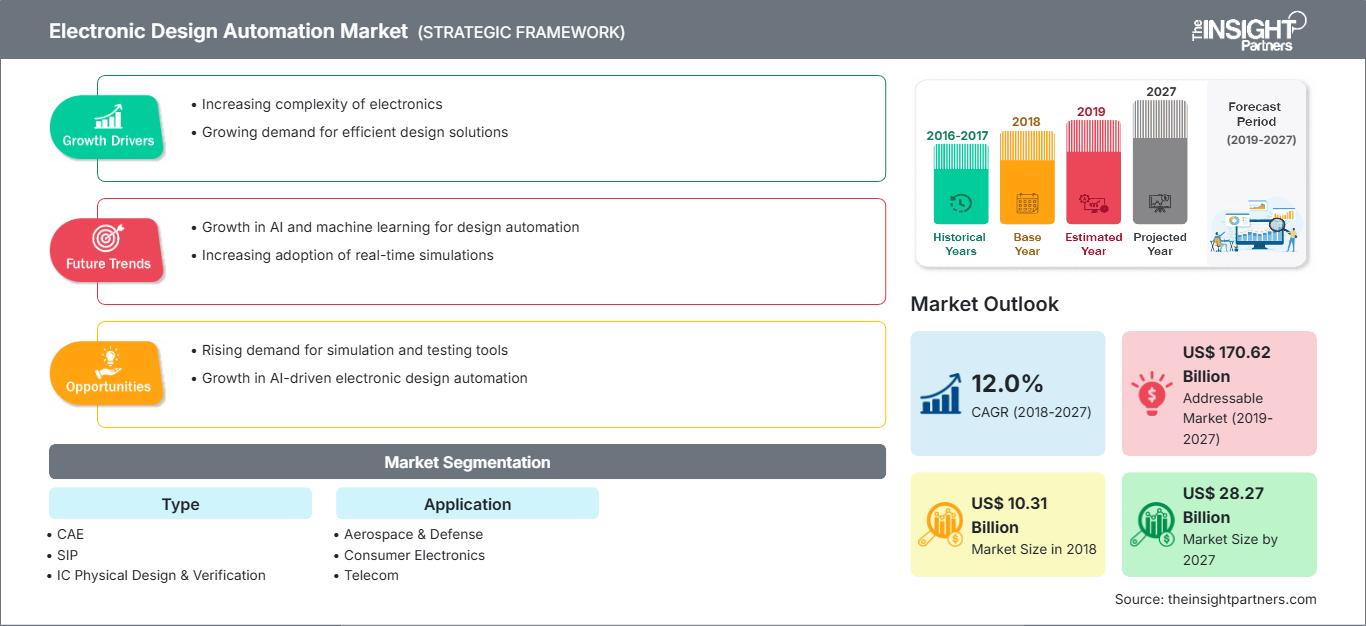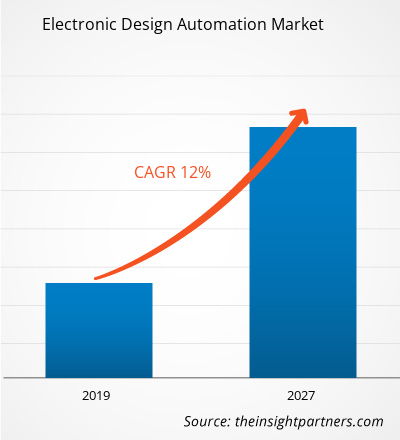El mercado de la automatización del diseño electrónico alcanzó los 10.310 millones de dólares estadounidenses en 2018 y se espera que crezca a una tasa de crecimiento anual compuesta (TCAC) del 12,0% durante el período de previsión 2019-2027, hasta alcanzar los 28.270 millones de dólares estadounidenses en 2027.
El software de automatización del diseño electrónico (EDA) comprende múltiples herramientas y aplicaciones. Integrar estas herramientas según las necesidades del cliente a veces resulta complejo. Los requisitos complejos de los usuarios finales en cuanto a un posicionamiento del producto altamente estable y preciso se satisfacen con la ayuda del EDA. La creciente complejidad y los elevados costes que afrontan las industrias para la implementación de diseños complejos y costosos son factores clave que impulsan la demanda de EDA.
Se prevé que la región de Asia-Pacífico domine el mercado de la automatización del diseño electrónico. Esto se debe principalmente al importante centro de producción de electrónica y semiconductores de China, sumado a la alta densidad de población de la región. Además, China concentra el mayor volumen de envíos de semiconductores a nivel mundial, y se espera que las nuevas iniciativas de mercado y las alianzas estratégicas continúen durante el período de pronóstico, lo que contribuirá al elevado crecimiento del mercado de la automatización del diseño electrónico en la región.
Obtendrá personalización gratuita de cualquier informe, incluyendo partes de este informe, análisis a nivel de país y paquetes de datos de Excel. Además, podrá aprovechar excelentes ofertas y descuentos para empresas emergentes y universidades.
Mercado de automatización del diseño electrónico: Perspectivas estratégicas

- Obtenga las principales tendencias clave del mercado que se describen en este informe.Esta muestra GRATUITA incluirá análisis de datos, que abarcarán desde tendencias de mercado hasta estimaciones y pronósticos.
Crecimiento de la industria de semiconductores
En octubre de 2018, la SIA (Asociación de la Industria de Semiconductores), representante del liderazgo estadounidense en investigación, diseño y fabricación de semiconductores, registró un aumento del 12,7 % con respecto a 2017, alcanzando unos ingresos totales de 41 800 millones de dólares. Asimismo, la WSTS pronosticó un crecimiento del 15,9 % en 2018 y del 2,6 % en 2019. Este crecimiento en la industria de semiconductores ha incrementado la confianza de los participantes del mercado de automatización del diseño electrónico en cuanto al crecimiento de sus ingresos. Las empresas que operan en el sector de los semiconductores no solo prevén un aumento sustancial de sus ingresos, sino que también están incrementando su inversión en I+D. El aumento interanual de la inversión en I+D ha impulsado notablemente el mercado de la automatización del diseño electrónico en los últimos años y se prevé que continúe haciéndolo en los próximos años.
Dado el sólido ciclo alcista que sigue experimentando la industria de semiconductores, se prevé que los líderes del mercado de automatización del diseño electrónico adopten un enfoque orientado al futuro, considerando mercados finales no convencionales como la inteligencia artificial, los vehículos autónomos y el IoT. Asimismo, es probable que las empresas de memorias también registren un aumento en sus ventas debido a la creciente demanda de tecnologías para centros de datos, teléfonos inteligentes y vehículos autónomos. La convergencia de diversos mercados de usuarios finales de semiconductores ha dado lugar a una importante expansión del sector, lo que a su vez ha impulsado el mercado de automatización del diseño electrónico en lo que respecta a tecnología, software y automatización.
Penetración creciente del IoT, la inteligencia artificial y la realidad virtual
Hogares inteligentes, televisores, teléfonos inteligentes, Internet de las Cosas, coches conectados e inteligencia artificial: la industria de la electrónica de consumo ha permeado todos los aspectos de la vida humana. La demanda global de electrónica de consumo se ha visto impulsada en gran medida por el deseo de los consumidores de contar con dispositivos más potentes, novedosos y con mejores prestaciones, lo que a su vez ha incentivado al sector a explorar constantemente innovaciones y tecnologías que no solo satisfagan la imaginación de las personas, sino que también sean asequibles y relevantes para sus necesidades diarias. En estos casos, el software EDA proporciona a los fabricantes de componentes electrónicos y a los tecnólogos la capacidad de diseñar prototipos adecuados para los dispositivos. Por lo tanto, se espera que las crecientes expectativas de los consumidores y la demanda en auge de electrónica de consumo impulsen el mercado de EDA en los próximos años.
A continuación se enumeran algunas de las estrategias recientes de algunos de los actores del mercado de la automatización del diseño electrónico:
2018: Cadence Design Systems, Inc. anunció una alianza estratégica con Green Hills Software para acelerar la seguridad en sistemas embebidos. Cadence Design Systems, Inc. invirtió 150 millones de dólares, lo que representa aproximadamente el 16 % de la participación accionaria en Green Hills.
2018: ON Semiconductor seleccionó a Keysight Technologies como socio de EDA para el desarrollo de una solución de diseño para dispositivos de potencia que se espera que aumente la confiabilidad y acelere el tiempo de comercialización.
2018: Synopsys, Inc. y Siemens AG anunciaron una colaboración para una amplia gama de proyectos de EDA. Además, Siemens y Synopsys resolvieron todos los litigios de patentes pendientes entre Synopsys y Mentor Graphics.
El informe segmenta el mercado global de automatización del diseño electrónico de la siguiente manera:
Perspectivas regionales del mercado de automatización del diseño electrónico
Los analistas de The Insight Partners han explicado en detalle las tendencias y los factores regionales que influyen en el mercado de la automatización del diseño electrónico durante el período de previsión. Esta sección también analiza los segmentos y la geografía del mercado de la automatización del diseño electrónico en Norteamérica, Europa, Asia Pacífico, Oriente Medio y África, y Sudamérica y Centroamérica.
Alcance del informe de mercado de automatización del diseño electrónico
| Atributo del informe | Detalles |
|---|---|
| Tamaño del mercado en 2018 | 10.310 millones de dólares estadounidenses |
| Tamaño del mercado para 2027 | US$ 28.270 millones |
| Tasa de crecimiento anual compuesto global (2018 - 2027) | 12,0% |
| Datos históricos | 2016-2017 |
| período de previsión | 2019-2027 |
| Segmentos cubiertos | Por tipo
|
| Regiones y países cubiertos | América del norte
|
| Líderes del mercado y perfiles de empresas clave |
|
Densidad de los participantes en el mercado de la automatización del diseño electrónico: comprensión de su impacto en la dinámica empresarial
El mercado de la automatización del diseño electrónico está creciendo rápidamente, impulsado por la creciente demanda de los usuarios finales debido a factores como la evolución de las preferencias de los consumidores, los avances tecnológicos y una mayor conciencia de los beneficios del producto. A medida que aumenta la demanda, las empresas amplían su oferta, innovan para satisfacer las necesidades de los consumidores y aprovechan las tendencias emergentes, lo que impulsa aún más el crecimiento del mercado.

- Obtenga una visión general de los principales actores del mercado de la automatización del diseño electrónico.
Mercado global de automatización del diseño electrónico - Por tipo
- Ingeniería asistida por computadora (CAE)
- Propiedad intelectual de semiconductores (SIP)
- Diseño físico y verificación de circuitos integrados
- Placa de circuito impreso (PCB) y módulo multichip (MCM)
Mercado global de automatización del diseño electrónico: por aplicación
- Aeroespacial y Defensa
- Electrónica de consumo
- Telecomunicaciones
- Automotor
- Industrial
- Otros
Mercado global de automatización del diseño electrónico - Por geografía
- América del norte
- A NOSOTROS
- Canadá
- México
- Europa
- Francia
- Alemania
- Italia
- España
- Reino Unido
- El resto de Europa
- Asia Pacífico (APAC)
- Porcelana
- India
- Japón
- Corea del Sur
- Resto de Asia Pacífico
- Resto del mundo (RoW)
- Sudamerica
- Oriente Medio y África
Mercado global de automatización del diseño electrónico: perfiles de empresas
- Agnisys Inc.
- Aldec, Inc.
- Autodesk, Inc.
- Cadence Design Systems, Inc.
- Labcenter Electronics Ltd.
- Tecnologías Keysight
- Mentor Graphics Corporation
- Silvaco, Inc.
- Synopsys, Inc.
- Zuken Inc.
- Análisis histórico (2 años), año base, pronóstico (7 años) con CAGR
- Análisis PEST y FODA
- Tamaño del mercado, valor/volumen: global, regional y nacional
- Industria y panorama competitivo
- Conjunto de datos de Excel
Informes recientes
Testimonios
Razón para comprar
- Toma de decisiones informada
- Comprensión de la dinámica del mercado
- Análisis competitivo
- Información sobre clientes
- Pronósticos del mercado
- Mitigación de riesgos
- Planificación estratégica
- Justificación de la inversión
- Identificación de mercados emergentes
- Mejora de las estrategias de marketing
- Impulso de la eficiencia operativa
- Alineación con las tendencias regulatorias






















 Obtenga una muestra gratuita para - Mercado de automatización del diseño electrónico
Obtenga una muestra gratuita para - Mercado de automatización del diseño electrónico